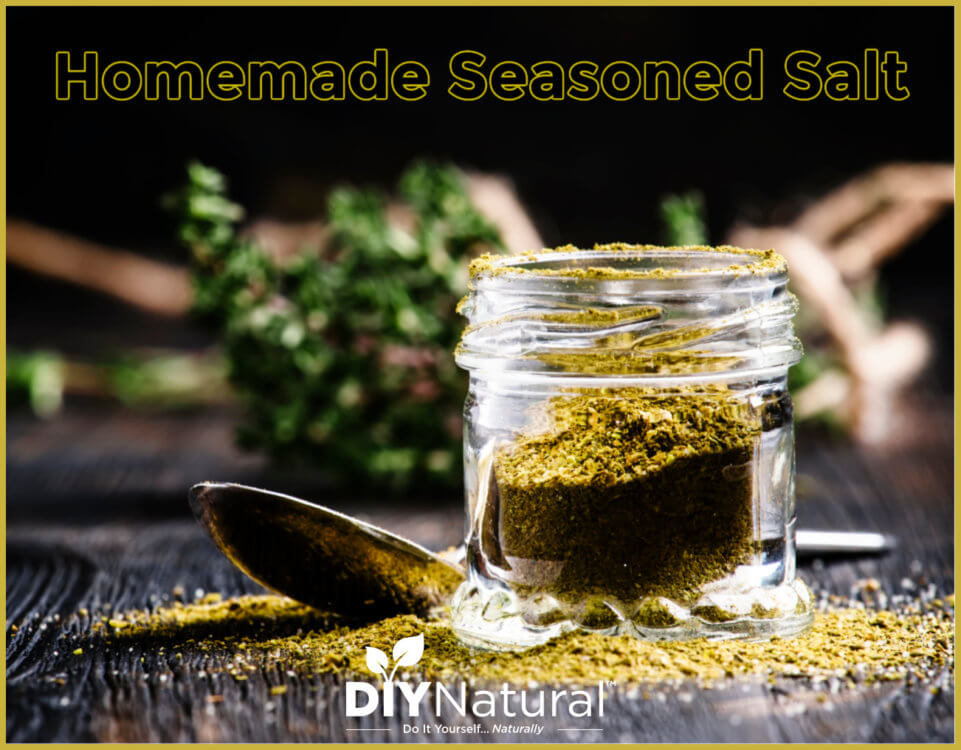

Making this homemade seasoned salt is very simple. Yes, you could dry all your own herbs like me, but it’s much easier to purchase and use bulk dried herbs.
I have a jar of seasoned salt that I use for most everything. From chicken to pork, hamburgers, and fresh-cut fries, there’s not much I don’t use it on. I’ve bought seasoned salt in the past, but they are heavy on the salt and lacking in flavor. I dry my own herbs, so this was easy to make.
Start With the Herbs
You can make your homemade seasoned salt with most any herbs, but coming up with a good blend is a little more difficult. Here is a list of the herbs that I use in my blend:
Of course, you can use other herbs like dried basil or oregano, but this blend is more universal and can be used for more things.
-
To begin making this homemade seasoned salt, be sure that everything is dried. Fresh herbs will cause mold and rot. Dry or dehydrate in the smallest pieces that you can manage. I cut mine small and dehydrate them but you can just purchase all the dried ingredients.
-
Use a mortar and pestle, spice mill, or coffee grinder to crush/blend into a granular or powder form and mix everything together.
-
Store in a larger container, pulling out enough for a shaker as above. I make a cheesecloth bag with some rice in it to absorb moisture.
You can also use this spice grinder to keep everything whole and grind fresh for each use.
You can use this homemade seasoned salt mix on almost anything. Remember that it does contain salt, so be sure not to use any additional salt or your meal may become inedible.
This recipe makes about 3 ounces. I make a large batch and keep it in a bucket. I pull out enough for a shaker jar and use just this small amount for a month or so. This keeps it from caking up due to the humidity. You can add a few grains of rice to help combat this too.
Serving: 2g | Calories: 11kcal | Carbohydrates: 3g | Protein: 1g | Fat: 1g | Saturated Fat: 1g | Sodium: 4652mg | Potassium: 12mg | Fiber: 1g | Sugar: 2g | Vitamin A: 445IU | Vitamin C: 3mg | Iron: 1mg
Substitutions for this Homemade Seasoned Salt
While you can follow the recipe exactly, personal preferences and dietary restrictions may prove otherwise. Here are some substitutions that you can make:
Salt
You can use plain salt if you wish. I used celery salt, but you can use Himalayan pink salt, sea salt, or even smoked salt for a different taste. You could even use a salt substitute here.
Sugar
I prefer raw sugar for this homemade seasoned salt recipe, with the molasses adding just a bit of different flavor. You can use white sugar, brown sugar, or even stevia or monk fruit. Remember that sugar substitutes are often more sweet than sugar, so start with a much smaller amount. You can also use less sugar than the recipe calls for if you wish.
Paprika
You can purchase ground paprika powder, or you can do what I did and use dehydrated bell peppers. I got them good and dry and ground them into powder.
Turmeric
This one is easier to buy dried in powder form, but you can dry your own. I grow turmeric every year. I cut the roots into thin disks and dry them well. Then I grind this into powder.
Onion
Any dried onion will work, but I prefer yellow onions for this homemade seasoned salt recipe. Yellow onions are sweet, but not as much as a Vidalia. They are sharp on onion flavor, but not as much as a white onion. For a milder onion flavor, use shallots.
Garlic
Thinly slice garlic cloves and dry in single layers. These can be ground very easily.
Cornmeal
This ingredient is optional, so it is up to you whether you use it or not. It helps to keep the ingredients evenly distributed. If you don’t use it, the lighter parts will stay on top while the heavier items, such as the salt, fall to the bottom.
Lemon Peel
I dry and grind my own lemon peel for this homemade seasoned salt, but you can use other things to get this citrusy taste. Citric acid is commonly used in salt blends to add tartness. Other things you can try are oxalis leaves, often found in your own yard or sourwood leaves. Both are easy to dry and use as condiments. I use sourwood leaves with chicken and fish and oxalis goes into salads. Oxalis does contain oxalic acid which can lead to irritation, but this small amount won’t cause any problems. Sumac berries, dried, can also be used. Be sure to only use red sumac berries as the white ones can be toxic.
Chives
This ingredient is optional but can add just a bit more flavor. Dry chive leaves whole, then crush and grind to a powder. They can be used in place of onions, or alongside them.
What dishes do you plan to use this homemade seasoned salt recipe on?
*******
Source: DIY Natural – Food






